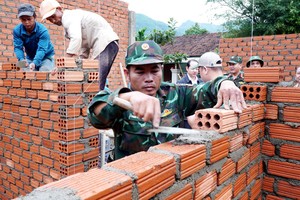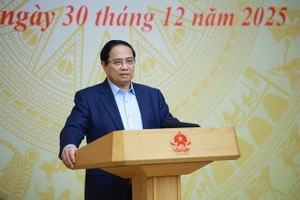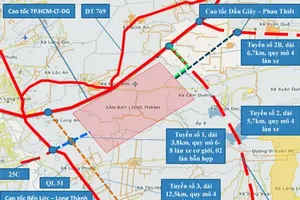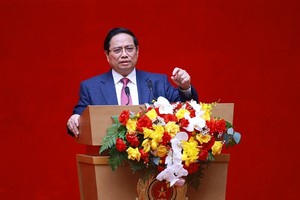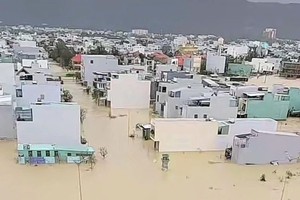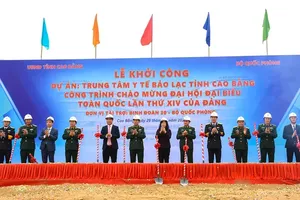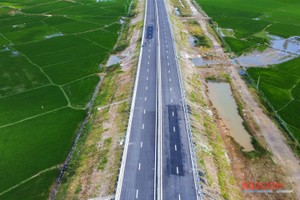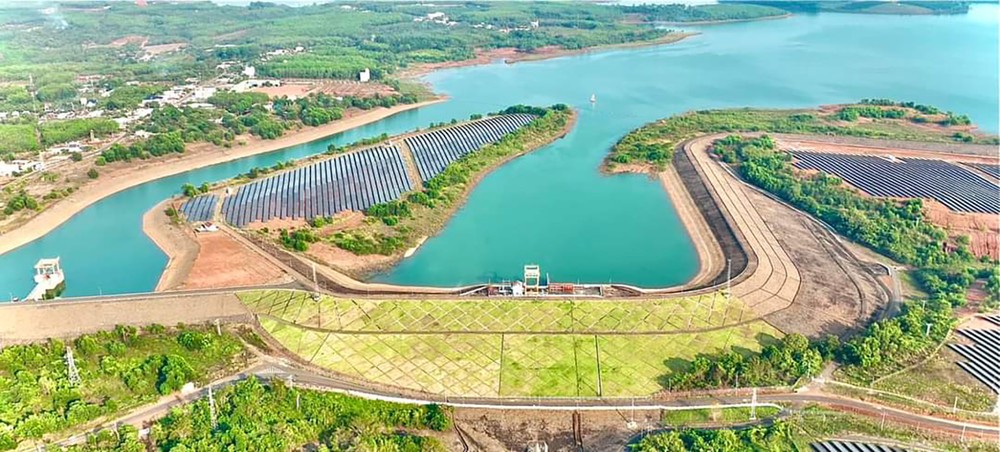
From Bu Gia Map National Park, we traveled down to the Thac Mo Hydropower Plant, which is constructed on the uppermost tier of the Be River within the districts of Bu Gia Map, Bu Dang, and the town of Phuoc Long in Binh Phuoc Province. This plant is a source of pride for the electricity sector and has contributed to transforming the landscape of eight districts and towns in Binh Phuoc Province.
Hydropower plants on the Be River
Climbing to the peak of Ba Ra Mountain (736m above sea level, located in Phuoc Long Town), we looked down and saw the water from the upstream highlands rushing toward the foot of the dam, churning white foam, then calming as it reached the Thac Mo dam.
In the distance, the Thac Mo Hydropower Plant lay deep in the valley, surrounded by majestic mountains and forests, along with hundreds of thousands of hectares of industrial crops cultivated by local residents. In the sounds of Thac Mo, there are drops of sweat mingled with the hardships and efforts of many generations of officials and workers, all for the power source in the vast wilderness.
As one of the first officers at the Thac Mo Hydropower Plant, Mr. Nguyen Cong Thang, Operation Manager, nostalgically recalled, ‘After 1975, the entire area bordering the districts of Bu Dang, Bu Gia Map, and Phuoc Long was a desolate, wild region with mountains and forests scarred by bombs. The roads were winding and steep, vegetation was dense, and travel was difficult.’
In the 1980s, the entire country, especially the Southern region, faced severe electricity shortages. The burgeoning industrial production demanded a significant amount of electricity, making the construction of hydropower plants urgent. From the project's inception, the surveying and design of the Thac Mo Hydropower Plant were carried out by domestic engineers, leading to the commencement of construction in November 1991.
With the support of Ukrainian experts, the first generator unit was activated on January 6, 1995, followed by the second unit on April 30, 1995, both connected to the national grid. In 2014, with approval from the Vietnam Electricity Corporation, Thac Mo Hydropower Joint Stock Company began expanding the Thac Mo Hydropower Plant, increasing its capacity from 150MW to 225MW. The expanded plant became operational at the end of 2017, providing an annual electricity output of 915 million kWh, helping reduce environmental pollution, water source contamination, and erosion in the Be River basin.
According to Mr. Nguyen Van Non, General Director of Thac Mo Hydropower Joint Stock Company, after 29 years of operation, the plant has contributed over 21 billion kWh of electricity to the national grid, with a reservoir capacity of about 1.3 billion cubic meters. The hydropower plant helps mitigate flooding in downstream areas during the rainy season, provides water for daily use during dry seasons, and, in recent years, has helped Binh Phuoc increase its annual budget revenue by approximately VND200 billion.
Non expressed his pride, saying, "Thac Mo is the first major hydropower project where Vietnam led in economic-technical feasibility, technical design, construction drawings, initiating self-financed investments in building and operating power plants." As electricity flowed, the thunderous sound of the waterfall resonated in all directions, illuminating the border region and revitalizing land scarred by wartime bombing, contributing significantly to the country's post-war socio-economic reconstruction efforts.
Opening up more power resources
Navigating through winding slopes and curves, we reach the Thac Mo Solar Power Plant, which boasts a total capacity of 50MWp and an investment of VND862 billion. Situated across Duc Hanh Commune in Bu Gia Map District and Thac Mo Ward in Phuoc Long Town on a 57-hectare site, the project is spearheaded by Thac Mo Hydropower Joint Stock Company. The plant has hundreds of fully covered glass panels on the hillside, quietly harnessing solar radiation to generate electricity. Set amidst forest and lake surroundings, it creates an unparalleled blend of natural and man-made beauty.
Employing cutting-edge photovoltaic technology, the project annually contributes 78 million kWh to the national grid, curbing greenhouse gas emissions, protecting the environment, and contributing VND26 billion to Binh Phuoc Province's budget annually. Recently, the Prime Minister approved Decision No.1489/QD-TTg outlining the provincial development plan for Binh Phuoc from 2021 to 2023, with a vision to 2050. Notably, the Thac Mo Solar Power Complex Phase 2, with a capacity of 375MWp, promises a substantial boost to the province's energy infrastructure expansion and development.
After departing from the Thac Mo Solar Power Plant, we visited the Can Don Hydropower Plant, operated by Can Don Hydropower Joint Stock Company. Situated adjacent to Bu Gia Map and Bu Dop districts in Binh Phuoc Province, the plant boasts a reservoir spanning over 19 square kilometers with a capacity of nearly 80 million cubic meters. It commenced operations in 2004 with two generator units, M1 and M2, totaling 77.6 MW. Annually, it contributes an estimated 294.4 million kWh of electricity to the national grid.
In addition to generating electricity, the Can Don Hydropower Plant utilizes its reservoir for irrigation purposes. By 2007, this included an 18,000-meter main canal and 26,965 meters of primary irrigation channels, funded with over VND300 billion from government bonds. This irrigation system provides water for 4,578 hectares of agricultural land across four communes and towns in Bu Dop District.
In the past, Ha Van Thanh, a farmer in Thanh Binh Town, Bu Dop District, had to install a costly D50 pipeline to ensure water for his rice fields. Since the completion of the Can Don irrigation project, his rice field no longer suffers water shortages.
Seeing water flowing into the irrigation system, Thanh shared that his family no longer worries about water scarcity during the rice planting season. They now cultivate rice year-round, harvesting over 700kg per 1,000 square meters for consumption and livestock feed. However, the Can Don irrigation project currently only meets 50-60 percent of the total irrigation area. Just about 1 km from the end of Canal N8 in Hamlet No.1, Thanh Hoa Commune, drought still affects approximately 30 hectares of rice fields because the branch canal has not yet reached there.
Downstream on the Be River, we stopped at the Srok Phu Mieng Hydropower Plant, invested by the Urban Development and Industrial Park Investment Corporation (IDICO) under the Ministry of Construction. The plant has two generator units with a total installed capacity of 51MW, supplying approximately 228 million kWh annually to the national grid and providing irrigation water for 57,500 hectares of agricultural land.
The hydropower plant's reservoir spans over 16.5 square meters, situated on the third terrace of the Be River, nestled within the Srok Phu Mieng valley. The lake is surrounded by lush green orchards and swift streams that flow along gentle hillsides, creating a picturesque and serene landscape. This area is also a popular destination for boat tours and water activities, especially among young people.
While we may momentarily appreciate the benefits brought by these power projects, it is crucial not to overlook the need for scientifically planned development of hydropower plants and subsequent solar facilities, alongside rigorous environmental impact assessments. This approach ensures a sustainable supply of electricity and irrigation water for daily life, production, and business needs while preserving precious primeval forests and allowing the majestic hydroelectric waterfalls to resonate along the Be River.








